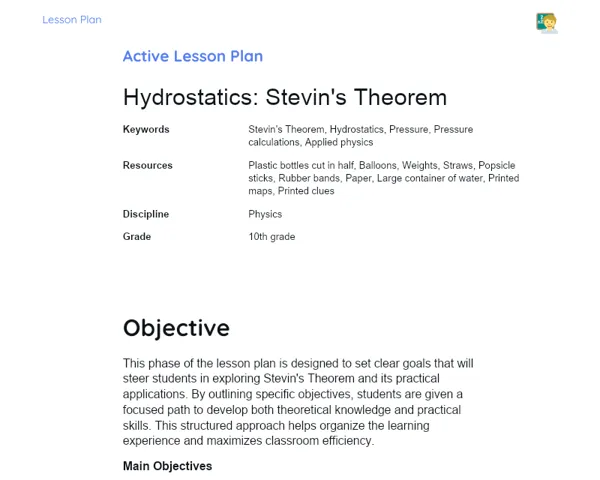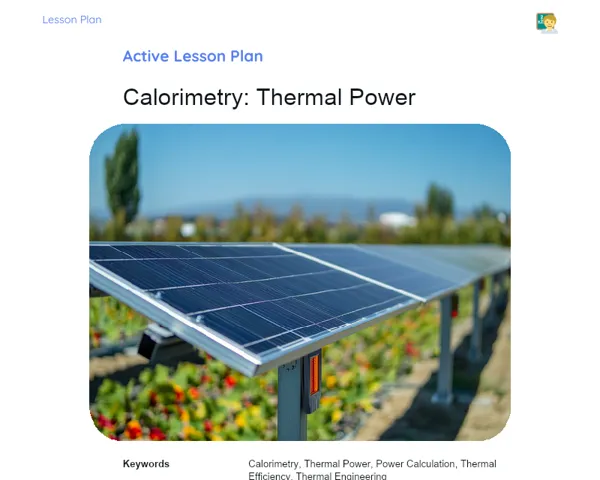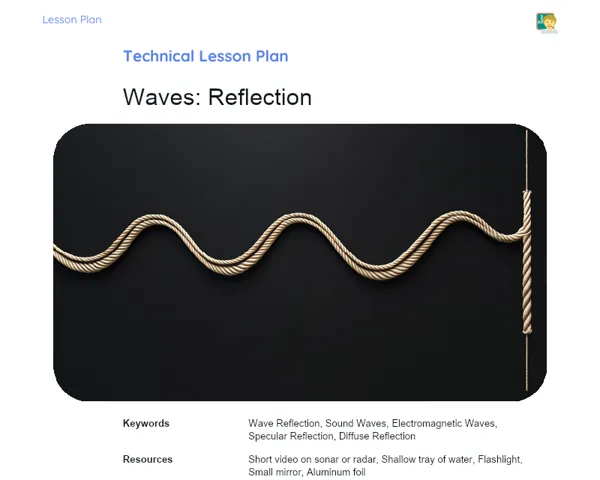Lesson Plan | Lesson Plan Tradisional | Momentum and Impulse: Collision and Momentum Problems
| Keywords | Momentum, Impulse, Impulse Theorem, Collisions, Conservation of Momentum, Elastic Collisions, Inelastic Collisions, Physics, 11th Grade Physics |
| Resources | Whiteboard and markers, Projector or screen for presentation slides, Visual aids or slides for explanations, Calculators, Notebooks and pens for note-taking, Reference materials with formulas and concepts, Sample problems for practice |
Objectives
Duration: (10 - 15 minutes)
The goal of this section of the lesson plan is to ensure students have a clear understanding of the learning outcomes. This clarity will help them identify what is expected by the end of the lesson and how the ideas of momentum and impulse relate to collision problems. Having clear objectives aids both teaching and learning, ensuring that everyone is on the same page regarding the lesson's goals.
Objectives Utama:
1. Comprehend the fundamental concepts of momentum and impulse.
2. Identify and utilize the impulse theorem in collision scenarios.
3. Determine conditions for momentum conservation in collision systems.
Introduction
Duration: (10 - 15 minutes)
🎯 Purpose: This part of the lesson aims to ignite students' curiosity about the topic and relate it to their daily experiences, making learning more engaging. By linking momentum and impulse to real-life instances, students can grasp the importance of these concepts and feel more enthusiastic about learning. Moreover, connecting the content to the real world aids in understanding and retention of the concepts to be discussed during the lesson.
Did you know?
🧐 Did You Know: Car airbags are engineered using the concept of impulse! When a collision occurs, sensors notice the rapid deceleration and trigger the airbag to inflate swiftly. This mechanism increases the impact duration and reduces the force on passengers, thereby minimizing injuries. This serves as an everyday example of how Physics contributes to saving lives!
Contextualization
📚 Context: Begin the lesson by discussing how momentum and impulse are key principles in Physics, relevant to many familiar scenarios. For instance, consider actions like throwing a cricket ball, driving a two-wheeler, or even engaging in sports such as cricket and badminton. These concepts are essential for understanding the motion of objects and their interactions during collisions. Emphasize that mastering these principles is crucial for tackling more intricate phenomena and practical applications, including airbags in vehicles and accident analyses.
Concepts
Duration: (45 - 55 minutes)
🎯 Purpose: This section intends to deepen understanding of momentum, impulse, and collisions through specific topics and problem-solving. By addressing practical problems, students will see the application of theoretical concepts in real life and build confidence in using these principles across different contexts. This hands-on approach is designed to solidify their learning and prepare them to effectively tackle Physics challenges.
Relevant Topics
1. 📜 Definition of Momentum (p): Explain that momentum is a vector quantity defined as the product of an object's mass (m) and velocity (v). Its formula is p = m * v. Stress that momentum has both direction and magnitude, which is vital for describing how objects move.
2. ⚖️ Conservation of Momentum: Clarify that in an isolated system with no external forces acting upon it, the total momentum remains constant. Use relatable instances, like two cricket balls colliding, to illustrate this principle.
3. 💥 Impulse (I): Describe impulse as the change in momentum of an object due to a force applied over a specific timeframe. The formula is I = F * Δt. Explain that impulse is also a vector quantity with its measurement unit being Newton-seconds (N·s) in the International System.
4. 🔄 Impulse Theorem: Introduce the impulse theorem, which indicates that the impulse exerted on an object equals the change in its momentum (I = Δp). Provide examples to show how this theorem allows us to calculate velocity changes during collisions.
5. 🎯 Types of Collisions: Differentiate between elastic and inelastic collisions. Explain that in elastic collisions, both momentum and kinetic energy are conserved, while in inelastic collisions, only momentum is conserved. Illustrate this with examples of each type.
6. 📝 Practical Examples: Work through example problems that involve calculating momentum, the impulse theorem, and conservation of momentum. Demonstrate step-by-step how to tackle these problems so that students grasp each part of the process.
To Reinforce Learning
1. 1. A car with a mass of 1,000 kg is moving at a speed of 20 m/s. What is the momentum of the car?
2. 2. During a collision, a force of 500 N acts on an object for 4 seconds. Calculate the impulse applied to the object.
3. 3. Two billiard balls, one weighing 0.5 kg and another weighing 0.8 kg, collide on a billiard table. The first ball moves at 2 m/s, while the second is stationary. Assuming an elastic collision, what are the velocities of the balls post-collision?
Feedback
Duration: (25 - 30 minutes)
🎯 Purpose: This part is focused on reviewing and reinforcing the knowledge gained during the lesson. Through discussions of the solved problems and engaging students with thoughtful questions, the aim is to clear up any confusion, strengthen understanding, and encourage critical thinkers about how to practically apply the concepts learned.
Diskusi Concepts
1. 1. Momentum of the Car: To find the momentum (p) of the car, we use the formula p = m * v. With m being 1,000 kg and v being 20 m/s, we get:
p = 1,000 kg * 20 m/s = 20,000 kg·m/s.
Hence, the momentum of the car is 20,000 kg·m/s. 2. 2. Impulse Applied to the Object: The impulse (I) is found using the formula I = F * Δt, where F is the applied force and Δt is the time interval. Given F as 500 N and Δt as 4 s, we find:
I = 500 N * 4 s = 2,000 N·s.
Therefore, the impulse applied to the object is 2,000 N·s. 3. 3. Collision of the Billiard Balls: For an elastic collision, both momentum and kinetic energy are preserved. We can use the following formulas:
Conservation of momentum:
m1 * v1i + m2 * v2i = m1 * v1f + m2 * v2f
Conservation of kinetic energy:
0.5 * m1 * (v1i)^2 + 0.5 * m2 * (v2i)^2 = 0.5 * m1 * (v1f)^2 + 0.5 * m2 * (v2f)^2
Plugging in the given values:
0.5 kg * 2 m/s + 0.8 kg * 0 m/s = 0.5 kg * v1f + 0.8 kg * v2f
and
0.5 * 0.5 kg * (2 m/s)^2 + 0.5 * 0.8 kg * (0 m/s)^2 = 0.5 * 0.5 kg * (v1f)^2 + 0.5 * 0.8 kg * (v2f)^2
Solving these equations gives us:
v1f = 0.8 m/s
v2f = 1.2 m/s.
Thus, after the collision, the first ball moves at 0.8 m/s and the second ball at 1.2 m/s.
Engaging Students
1. 🔍 Discussion Questions: 2. What role does understanding momentum and impulse play in our everyday lives? 3. How can the principle of conservation of momentum be observed in scenarios like sports events or accidents? 4. Why is it important to distinguish between elastic and inelastic collisions? 5. In what practical scenarios can the impulse theorem be beneficial, such as in safety equipment development?
Conclusion
Duration: (10 - 15 minutes)
The aim of this concluding segment is to summarize and reinforce the key concepts explored in the lesson, ensuring students retain the essential ideas surrounding momentum, impulse, and collisions. Recapping aids in clarifying any lingering doubts and consolidating learning, preparing students to use these principles in future problem-solving.
Summary
["Momentum (p) is a vector quantity calculated as the product of an object's mass (m) and velocity (v), expressed as p = m * v.", 'In an isolated system, the total momentum remains unchanged.', 'Impulse (I) represents the change in momentum of an object, calculated through the formula I = F * Δt, where F is the force and Δt is the time the force is applied.', 'The impulse theorem posits that the impulse exerted on an object equals the change in its momentum, I = Δp.', 'Elastic collisions conserve both momentum and kinetic energy.', 'In inelastic collisions, only momentum is conserved, while kinetic energy is not.']
Connection
This lesson bridged theory and practical application by using relatable examples like billiard ball collisions and how airbags function to clarify the concepts of momentum and impulse. We tackled real-world problems that illustrated the application of these theories, reinforcing students' appreciation of their relevance in Physics and daily life.
Theme Relevance
Grasping momentum and impulse is vital for numerous practical and technological uses, including designing safety tools (like airbags) and analyzing accidents. These principles are fundamental in forecasting and understanding the behavior of moving objects, making them crucial for engineers, physicists, and a variety of other professionals.



